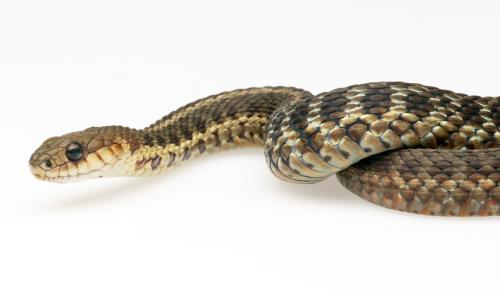
Scientific name:Thamnophis sirtalis pallidulus
Mi’kmaq Translation: Mte’skm
French Translation: Couleuvre rayée des Maritimes
Gaelic Translation: Nathair glùinean mara
Physical Description
Garter snakes have a wide range of colour variations, but tend to be brown, red or dark green. They have up to three yellow stripes – one dorsal stripe and two lateral stripes. A dorsal stripe extends along the back, while lateral stripes extend along either side of the animal. Most garter snakes have white, brown or black checkered or speckled patterning along the back. Although rare, some are partially to completely black in colour, often referred to as being melanistic.
Size
Young garter snakes measure about 10cm long
Adult males measure 40 to 60 cm long
Adult females measure 40 to 90 cm long
Range and Distribution
Garter Snakes are widely distributed throughout North America, from the Southern North West Territories to Costa Rica. The Maritime Garter Snake is one of seven sub-species of Garter Snake, represented throughout Quebec, Nova Scotia, New Brunswick and Prince Edward Island.
Habitat
They are widespread across Nova Scotia in a variety of habitats, including forests, wetlands, shorelines, fields and rocky areas, farmlands, and some larger coastal islands. They can also be found in many urban areas where they can find shelter under rocks and logs. Garter snakes often overwinter in groups underground below the frost line. Mammal burrows, rock crevices or human made structures often provide a great place to spend the winter months.
Diet
Garter snakes predate on many types of small animals. Earthworms and red-backed salamanders are key food sources for young snakes. Adults will feed on small fish, earthworms, salamanders, toads, tadpoles, frogs and small rodents.
Reproduction and Life Cycle
Breeding occurs in the spring, soon after the snakes emerge from hibernation. Females give birth between early August to mid-September to live young, ranging in number of 5 to 50 babies per snake. Young snakes develop into mature adults within two to three years. Garter snakes have a life span of up to 20 years.
Status
NSESA: Of Least Concern
COSEWIC: Not Assessed
Threats
Road mortality is significant for populations around urban areas or busy roadways. Habitat loss is a threat for all snake species, but Garter snakes can adapt and persist in regions with low to moderate human disturbance.